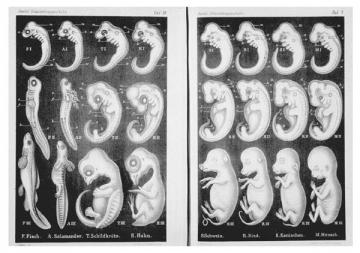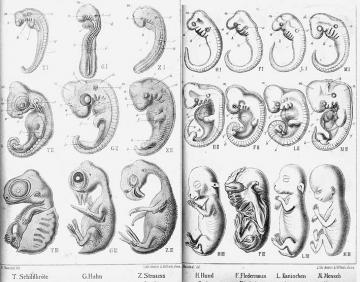It has been widely noted that a number of the embryos in top row of the Tables 6 and 7 from Haeckel's Anthropogenie (1874) are not realistic representations. However, the assertion by Explore Evolution that Haeckel claimed that top row represented earliest embryos is false. Nor are the book's claims that Haeckel engaged in fraud justified by current historical scholarship.
 Haeckel's Diagrams: embryonic development, as drawn by Ernst Haeckel
Haeckel's Diagrams: embryonic development, as drawn by Ernst Haeckel Illustrations from Ernst Haeckel, Anthropogenie, 4th ed. (1891): Reproduced from Richards (2009)
Illustrations from Ernst Haeckel, Anthropogenie, 4th ed. (1891): Reproduced from Richards (2009) When considering Haeckel's embryos, it is important to note that Haeckel compared embryos of different groups in several publications. For example, in Naturliche Schopfungsgeschichte (1868), Haeckel compared vertebrate embryos including human and dog. But his most famous diagram are Plates 4 and 5 from Anthropogenie (1874). Explore Evolution uses a version of this diagram from Romanes (1894) that is not completely identical to Haeckel's original (1874) diagram. Haeckel himself updated his illustrations over several editions (compare figures at right).
A diagram showing real vertebrate embryos by Michael Richardson and colleagues (used in Figure 4.2 of Explore Evolution) suggest that Haeckel took considerable license in portraying the earlier embryos in the series, particularly in the top row. Scholars who have studied Haeckel generally think the reason why Haeckel exaggerated similarities of early embryos was not to mislead his readers. A key difference between Richardson's figures and Haeckel's is that Richardson did not remove the yolk from his embryos. The yolk distorts the comparative outline of the embryos and alters the posture of the embryo in ways with no evolutionary or developmental significance.
Explore Evolution also claims that Haeckel misled his readers into thinking that the top row of embryos is the earliest embryonic stage. This charge about mislabeling the top row embryos as earliest was first made by Jonathan Wells in 2000 and has been refuted by Alan Gishlick at the National Center for Science Education. Nonetheless, Explore Evolution continues this false charge.
The stage that Haeckel labeled first is actually midway, through development. Embryologists such as Sedgwick knew this, but their publications challenging the Darwinian interpretation were lost beneath the popularity of Haeckel's inaccurate (and possibly fraudulent) drawings.Explore Evolution, p. 68
It is notable that none of Haeckel's contemporary critics, including Sedgwick, accused him of claiming that the embryos in his famous diagram were at the earliest stage. (Richardson and Keuck, 2002; Sedgwick, 1894)
Nick Hopwood, an historian of science, has comprehensively explored the production of Haeckel's embryos diagram (Hopwood, 2006) and shows that Haeckel's own writings would not have been taken by contemporaries to represent the earliest stages of development. Hopwood describes the original diagram with the following figure legend from Hopwood's paper in Isis. Quotation marks below are in the original and represent the English translation of Haeckel's description of the diagram.
"Comparison of the embryos of various vertebrates at three different stages of development. This expanded double plate shows fish (F), salamander (A), turtle (T), chick (H), pig (S), cow (R), rabbit (K), and human (M) embryos at very early (I), somewhat later (II), and still later (III) stages Lithograph by J. G. Bach of Leipzig after drawings by Haeckel from his Anthropogenie (Leipzig: Engelmann, 1874), Plates IV V.Nick Hopwood, 2006. "Pictures of Evolution and Charges of Fraud: Haeckel's Embryological Illustrations"Isis: 97:292
What did Haeckel mean by "very early" embryos? The definition of embryos has changed over the last 100 years. Unlike the modern definition of embryos, which refers to any stage after the fertilized egg, the 19th century definition of embryo was more restricted.
In present English usage, the term "embryo" includes even the earliest stages. The German tradition, however, largely established by von Baer, restricts the term "embryo" to the basic rudiment of the body or its later stages (the "embryo proper" in English usage). This is evident from many remarks by von Baer, for instance: "The germ ["Keim", blastodisc] during its growth transforms into two parts; [ ] the middle forms the embryo, the much wider periphery the Keimhaut [extraembryonic blastoderm]" (von Baer, 1828, p.44).Klaus Sander and Urs Schmidt-Ott, 2004. "Evo-Devo aspects of classical and molecular data in a historical perspective," J. Exp. Zool. (Mol. Dev. Evo) 302B:69 91.
Thus, Haeckel's "very early" embryos are midway through development and were not meant to represent the earliest stages of development.
When Explore Evolution claims that "the pictures were fabricated and the facts were distorted" (p. 69), the authors are ignoring recent scholarship. In addition to Hopwood's reassessment of Haeckel's original writings, historian Robert Richards has reexamined the drawings and their sources, finding no support for the claim of intentional fraud. Richards notes that Anthropogenie was a popular work based on a series of lectures Haeckel presented. The figures began as visual aides for his lecture, and represented the best illustrations available at the time. In Haeckel's subsequent writings, he replaced those illustrations as newer and better illustrations became available.
Richardson and his colleagues selected images from the first edition of Haeckel s Anthropogenie, which was hastily drawn together from his lectures. The book, though, went through five further editions. With each new edition the text grew fatter as Haeckel deployed more evidence; and the illustration in question expanded the comparison from 8 species of embryo to 20 by the 5th edition (1905). In the subsequent editions, the images grew ever more refined, so that even by the 4th edition (1891), the differences among them became more pronounced. The refinements were a function of more material available and better instrumentation (embryos at the earliest stages are invisible to the naked eye). Had the Science article compared Richardson s photos with illustrations from Haeckel s later editions, the argument for fraud would have withered.Robert J. Richards (2009) "Haeckel's embryos: fraud not proven" Biology and Philosophy 23:147-154.
This level of historical detail would be irrelevant to a class covering modern biology, but if Explore Evolution is to use this obscure debate to attack evolution, it behooves them to accurately describe the history. The best available historical research shows that Haeckel's drawings of embryos represented the best available illustrations, and were not a fraud.
